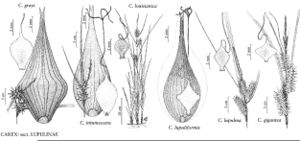Difference between revisions of "Carex lupulina"
Sp. Pl. 4(1): 266. 1805.
FNA>Volume Importer |
FNA>Volume Importer |
||
| Line 48: | Line 48: | ||
|publication year=1805 | |publication year=1805 | ||
|special status= | |special status= | ||
| − | |source xml=https://jpend@bitbucket.org/aafc-mbb/fna-data-curation.git/src/ | + | |source xml=https://jpend@bitbucket.org/aafc-mbb/fna-data-curation.git/src/f6b125a955440c0872999024f038d74684f65921/coarse_grained_fna_xml/V23/V23_957.xml |
|genus=Carex | |genus=Carex | ||
|section=Carex sect. Lupulinae | |section=Carex sect. Lupulinae | ||
Revision as of 19:10, 24 September 2019
Plants loosely cespitose or not, short-rhizomatous. Culms solitary or not, erect, 20–100(–130) cm. Leaves 4–8; basal sheaths reddish to brownish; sheath of distal leaf (1.3–)1.7–10(–25) cm; ligules triangular, 3.5–18 mm; blades 15–64 cm × 4–15 mm. Inflorescences 4–40 cm; peduncles of proximal spikes 0.5–20 cm, basal 2 peduncles 1–20 cm apart of terminal spike 0.5–6(–7) cm, shorter than or exceeding distal pistillate spike by 2 cm or less; bracts leafy, sheaths 0.5–15 cm, blades 13–55 cm × 3–11 mm. Spikes: proximal pistillate spikes (1–)2–5, distal spikes usually ± crowded, ascending, densely (4–)8–80-flowered, ovoid to cylindric, 1.5–6.5 × 1.3–3 cm; terminal staminate spikes 1(–2), 1.5–8.5 cm × 1–5 mm. Pistillate scales 1–7-veined, lanceolate to lanceolate-ovate, 6–15 × 1–2.7 mm, apex acute to awned, awns rough, to 6 mm. Anthers 3, 3–5.5 mm. Perigynia ascending, strongly 13–22-veined, ± stipitate, lance-ovoid, 11–19 × 3–6 mm, shiny, glabrous; beak conic, 6–10 mm. Achenes stipitate, rhomboid, flat to concave faces, angles smoothly thickened, not pointed or nobbed, 3–4(–4.5) × 1.7–2.6(–2.8) mm; style same texture as achene.
Phenology: Fruiting late spring–summer.
Habitat: Wet, deciduous or mixed swamp forests, forest openings, wet meadows
Elevation: 0–700 m
Distribution

N.B., N.S., Ont., Que., Ala., Ark., Conn., D.C., Fla., Ga., Ill., Ind., Iowa, Kans., Ky., La., Maine, Md., Mass., Mich., Minn., Miss., Mo., Nebr., N.H., N.J., N.Y., N.C., Ohio, Okla., Pa., R.I., Tenn., Tex., Vt., Va., W.Va., Wis.
Discussion
Occasional specimens have been seen that appear to be sterile hybrids of Carex lupulina with C. retrorsa or C. lurida.
Selected References
None.
